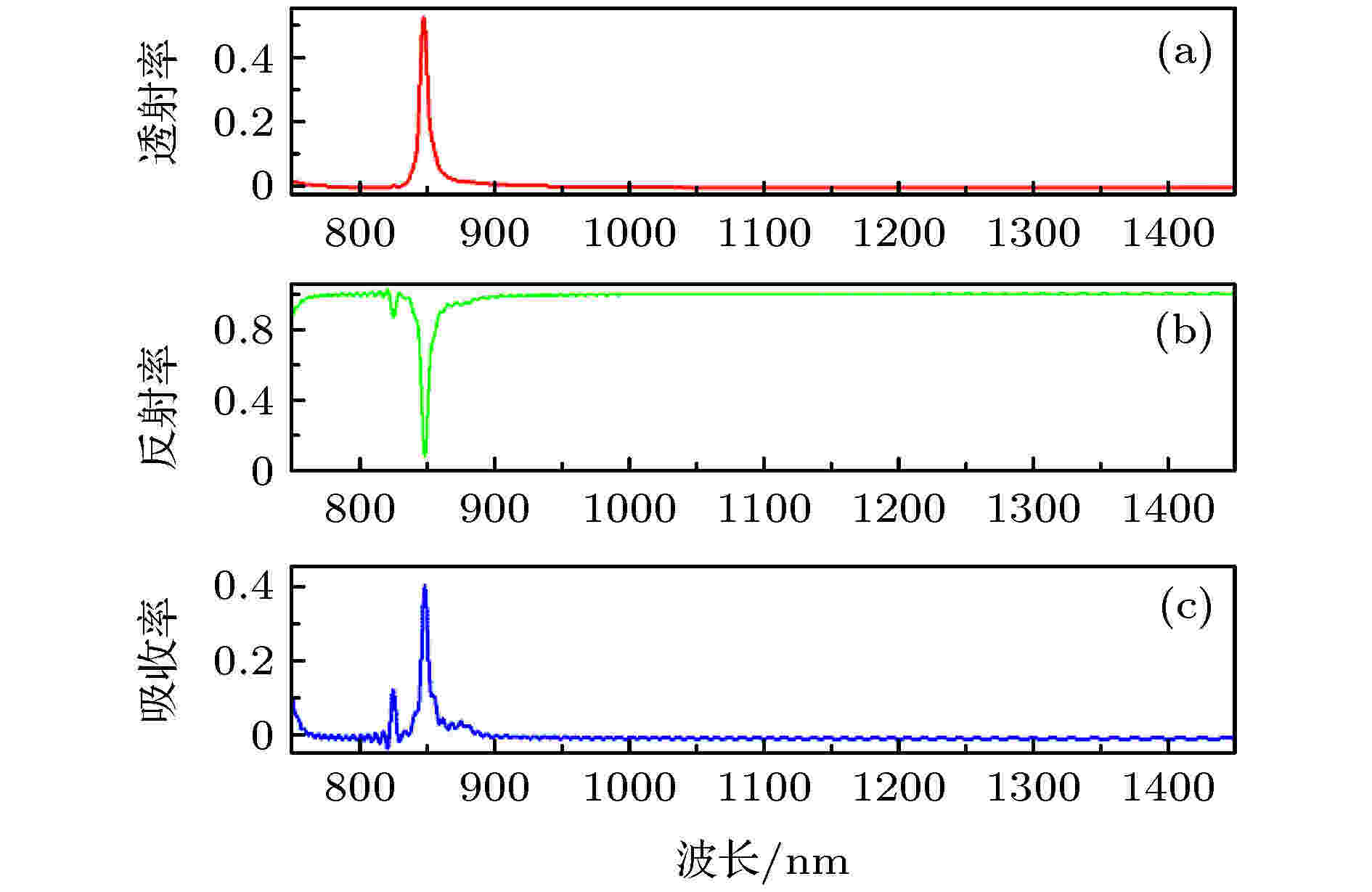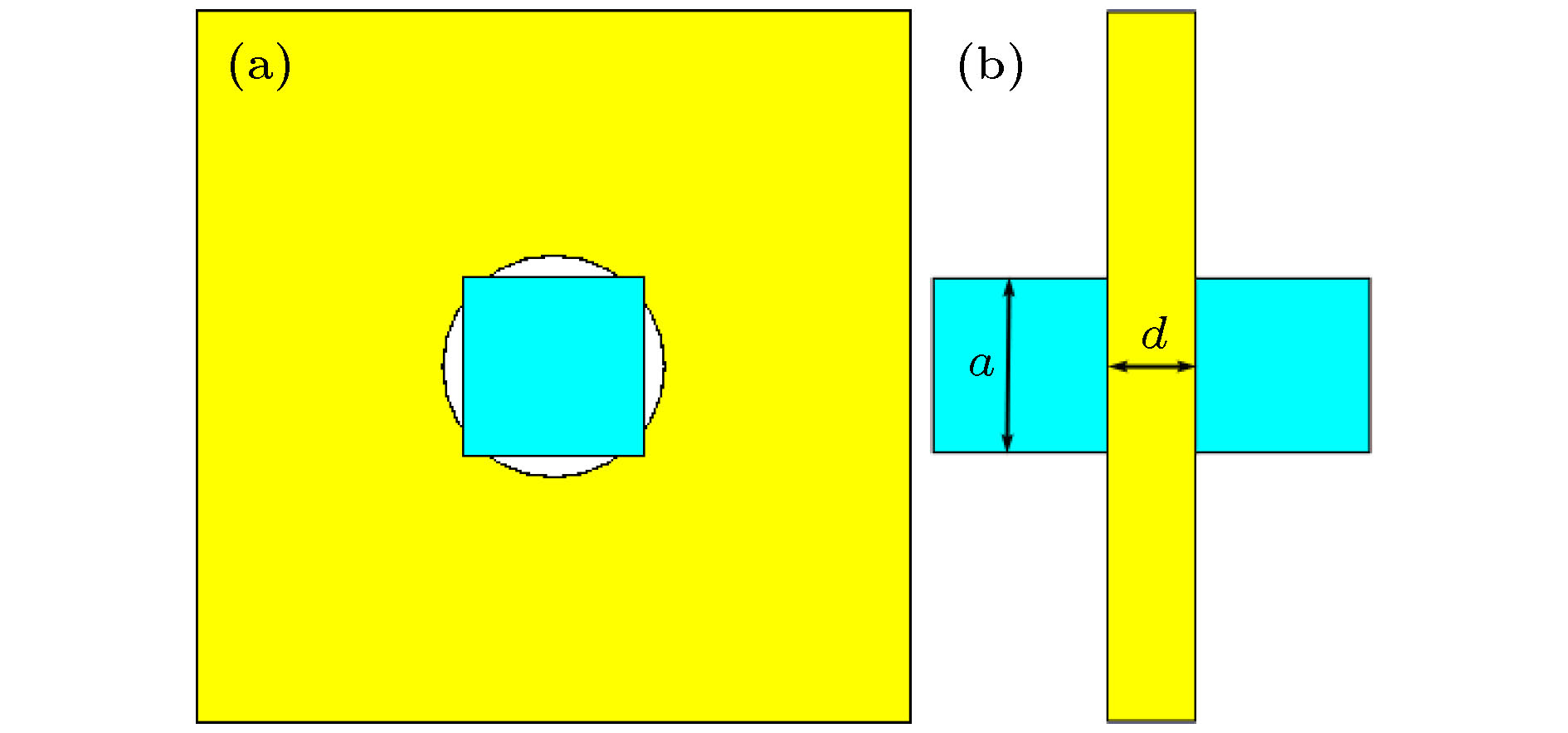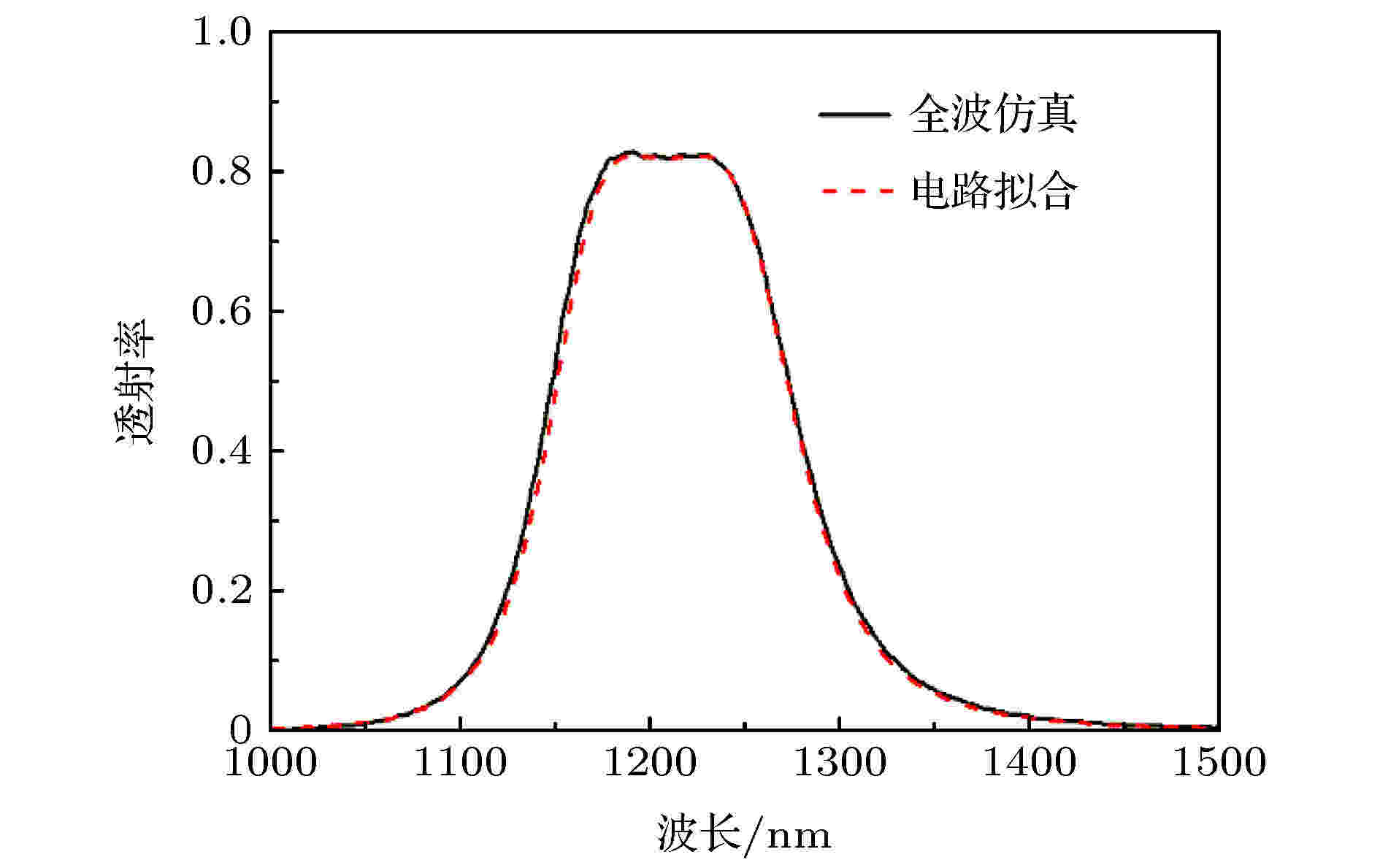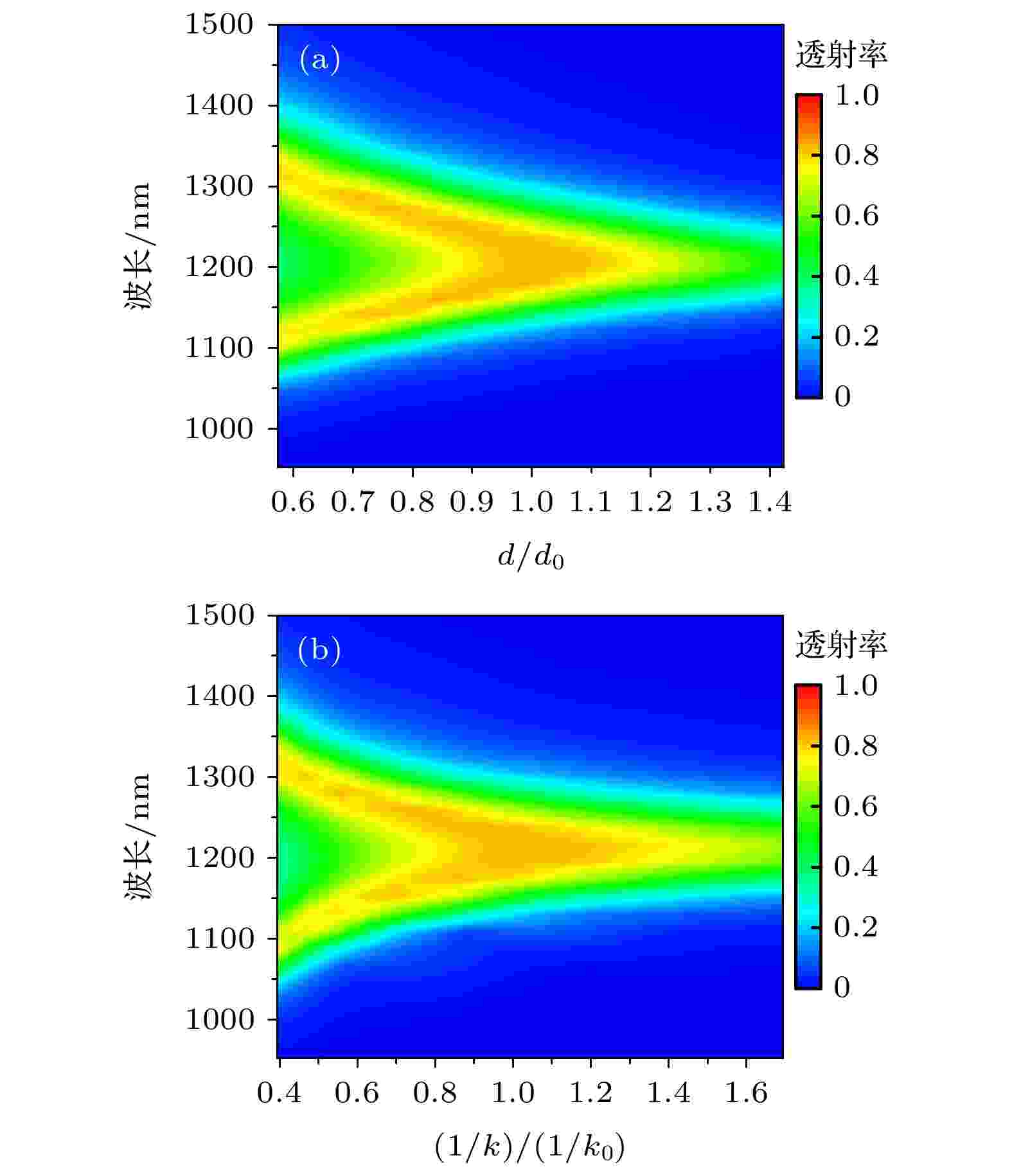摘要: 表面等离激元共振激发的亚波长金属孔透射较Bethe理论有大幅度的提高, 然而, 由于共振对频率的敏感性以及金属在光频的高损耗特性, 表面等离激元共振难以实现亚波长金属孔的宽带高透射传输. 本文采用放置在金属孔两边的硅纳米颗粒的Mie谐振耦合取代表面等离激元共振, 实现亚波长金属孔的宽带高透射传输. 全波仿真结果表明, 采用Mie谐振耦合的亚波长金属孔(
r /
λ = 0.1)光传输, 透射系数超过90%的带宽达到65 nm, 与表面等离激元共振诱导的透射增强相比, 峰值增高了1.5倍, 3 dB带宽拓宽了17倍. 根据耦合模理论, 建立了Mie谐振耦合亚波长金属孔透射的等效电路模型, 并在临界耦合状态下反演出电路模型中的元件参数值. 进一步研究发现, 仅通过改变等效电路模型中的耦合系数, 就可全面揭示Mie谐振耦合亚波长金属孔透射的传输规律, 并得到与全波电磁仿真完全一致的结果, 从而找到光与放置硅纳米颗粒的亚波长金属孔相互作用的数学表达, 也给予人们在光学领域按照电路设计方法构建相应功能模块的启示.
关键词: 亚波长金属孔 /
宽带 /
高透射 /
Mie谐振 English Abstract Broadband and high transmission of Mie-resonance-coupled subwavelength metal aperture Lü Xiao-Long 1 ,Lu Hao-Ran 2 ,Guo Yun-Sheng 1 1.School of Science, Inner Mongolia University of Science and Technology, Baotou 014010, China Fund Project: Project supported by the National Natural Science Foundation of China (Grant Nos. 61675103, 51862027) and the Natural Science Foundation of Inner Mongolia Autonomous Region, China (Grant No. 2018JQ03)Received Date: 14 July 2020Accepted Date: 08 September 2020Available Online: 22 January 2021Published Online: 05 February 2021Abstract: Transmission of the subwavelength metal aperture excited by the surface plasmon resonance is much higher than that from the Bethe theory. However, due to the sensitivity of resonant frequency and the loss of metal in optical band, it is difficult to achieve broadband and high transmission of the subwavelength metal aperture through surface plasmon resonance. In this article, the broadband and high transmission of the subwavelength metal aperture is realized when Mie-resonant-coupled silicon nanoparticles placed on both sides of the metal aperture are used to replace the surface plasmon resonance. The full wave simulation results show that bandwidth of the transmission coefficient more than 90% of the subwavelength aperture ($ {r \mathord{\left/ {\vphantom {r {\lambda = 0.1}}} \right. } {\lambda = 0.1}}$ ) reaches 65 nm by using Mie-resonance-coupled silicon nanoparticles. Compared with the transmission induced by surface plasmon resonance, the peak value is improved by 1.5 times and the 3 dB bandwidth is widened by 17 times. According to the coupled mode theory, the equivalent circuit model of transmission of the subwavelength metal aperture added with Mie-resonance-coupled silicon nanoparticles is established, and the element parameters in the circuit model are inversed under the critical coupling state. Further research shows that transmission rule of the subwavelength metal aperture added with Mie-resonance coupled silicon nanoparticles can be accurately revealed by changing the coupling coefficient in the equivalent circuit model, and the results are consistent with the full wave electromagnetic simulation results. The mathematical expression of the interaction between light and Mie-resonance-coupled subwavelength metal aperture is found, therefore it can inspire us to construct certain functional modules in optical field according to circuit design method.Keywords: subwavelength metal aperture /broadband /high transmission /Mie resonance 全文HTML --> --> --> 1.引 言 人们对亚波长金属孔的透射增强进行了较长时间的研究[1 -3 ] , 然而, 在实现机理上, 大部分研究采用的是基于表面等离激元共振实现亚波长金属孔的透射增强[4 -6 ] . 尽管它相对于Bethe理论能有大幅度的提高, 但是, 金属表面产生的等离激元对入射光能量有一定程度的吸收损耗[7 ,8 ] , 所以很难利用它获得亚波长金属孔的高透射传输. 另外, 表面等离激元共振对入射光频率有极大的敏感性, 由此实现的亚波长金属孔透射光增强的带宽非常窄[9 ,10 ] , 这进一步限制了它的应用, 尤其是在一些要求宽带的场合. 因此, 探索基于非表面等离激元实现亚波长金属孔的宽带高透射传输具有重要的意义.[11 -15 ] . 然而, 金属材料在光波段的损耗是不可忽略的, 以及介质材料对光波的响应结果并不像对微波的响应那样能使介电常数在几到几千甚至更高的范围内变化, 所以, 光频谐振子在材料的选择上受到极大限制. 不过, 诸如硅或锗等半导体材料具有光频吸收损耗小、介电常数高(10—20)以及与半导体工艺兼容性强等优点, 近年来以半导体纳米颗粒谐振子为单元构建的光学超表面在波阵面调控[16 ] 、电磁诱导透明[17 ] 、非线性效应[18 ,19 ] 以及纳米光学天线[20 ,21 ] 等方面的应用非常广泛. 本文通过在亚波长金属孔两边对称地放置硅纳米颗粒谐振子, 用颗粒的Mie谐振取代金属表面的等离激元共振, 并通过调整两谐振子间的耦合距离使它们达到临界耦合状态, 由此实现表面等离激元共振难以得到的宽带高透射传输, 有望在未来应用于光学传输和滤波等方面.2.理论研究与数值计算 22.1.亚波长金属孔的表面等离激元传输性能 2.1.亚波长金属孔的表面等离激元传输性能 本文选用的亚波长金属孔, 是在厚度为100 nm的金(Au)薄膜上排列的正方圆孔阵列, 圆孔的半径r = 125 nm, 周期为800 nm, 单元结构如图1(a) 所示. 在可见光及近红外波段, 金属材料的介电属性用Drude模型定义[22 ] , 其中等离子频率为1.37 × 1016 Hz, 碰撞频率为6.48 × 1013 Hz. 单元结构的四周分别设置为理想电壁(PEC)对以及理想磁壁(PMC)对, 以模拟平面波正入射的情形. 整个模型在CST Microwave Studio软件中建立, 采用时域有限积分法对亚波长金属孔的电磁响应进行计算. 研究表明, 在整个长波长区域, 亚波长金属孔对平面波的透射和吸收都非常小, 入射波的大部分能量被反射回去. 在波长为838 nm处及更短波长的区域内, 产生了一系列的透射峰. 这些透射峰是由入射到金属表面的光波在周期性圆孔的调制下转化为表面等离激元模式并与金属孔的波导模式耦合在一起穿透金属孔形成的[5 ] . 在这些透射峰中, 模式的混杂和相互耦合, 加大了人们对单纯的由周期性圆孔散射形成的表面等离激元模式的辨别和寻找难度, 然而, 光与金属中电子的相互作用并由此产生的表面等离激元引起的透射增强总是存在的. 所以, 对这些透射增强峰的研究, 能够反映出金属表面等离激元的基本光学特性. 本文选择短波区域838 nm处出现的第一个透射峰作为研究对象. 图1(b) 为838 nm波长的入射光照射下亚波长金属孔两边的电场分布. 可以看到, 由于表面等离激元的存在使电磁场重新分布, 导致电场在金属孔口两边的空间高度局域化, 磁场在孔两边的金属表面上高度局域化, 坡印亭矢量在金属孔口处达到最大且从入射端流向出射端(磁场和坡印亭矢量图中未给出), 从而实现了亚波长金属孔的透射光增强. 图1 (c)为入射光能量在金属板上的功率损耗密度, 与金属板的其他位置相比, 孔口边缘处的损耗非常大, 电场的趋肤深度$\delta $ 可达到27 nm, 与用解析解$\delta = c/(\omega n'')$ 求得的结果完全一致, 这里c 代表真空中光速, $\omega $ 为入射光角频率, $n''$ 为金属折射率的虚部(从Drude模型中的介电参数值求得). 与透射增强的机理一样, 功率损耗也是由表面等离激元引起的. 所以, 由表面等离激元实现的亚波长金属孔透射光增强, 必然要伴随较大的能量损耗.图 1 亚波长金属孔的(a)单元结构、(b)电场分布以及(c)功率损耗密度分布Figure1. Unit cell (a), electric field distribution (b), and power loss density distribution (c) of the subwavelength metal aperture.图2(a) —(c) 分别给出了波长范围为750—1500 nm的入射光垂直照射金属孔时的透射率T 、反射率R 和吸收率A , 这里$T = {\left| {{S_{21}}} \right|^2}$ , $R = {\left| {{S_{11}}} \right|^2}$ , $A = 1 - {\left| {{S_{21}}} \right|^2} - {\left| {{S_{11}}} \right|^2}$ , S 21 和S 11 分别为透射和反射系数, 由二端口网络计算给出. 可以看到, 波长为838 nm处表面等离激元的共振使入射光实现了透射增强, 峰值达0.55, 3 dB带宽为8 nm, 对应的反射率为0.07, 吸收率为0.38, 透射率与反射率之比为1.45, 有38%的入射波能量被吸收损耗掉. 在其他波长处, 由于没有激发起表面等离激元, 透射率几乎为0, 吸收损耗也几乎为0, 大部分能量被反射回去.图 2 平面波通过亚波长金属孔的(a)透射率、(b)反射率和(c)吸收率Figure2. (a) Transmissivity, (b) reflectivity and (c) absorptivity of plane waves passing through the subwavelength metal aperture.2.2.亚波长金属孔的Mie 谐振耦合传输性能 -->2.2.亚波长金属孔的Mie 谐振耦合传输性能 光作用到物质上使物质发生极化, 极化率的求解是计算物质内、外叠加场强以及进一步计算物质对光波散射和吸收的前提. 当颗粒物质的几何尺寸小于入射光波波长时, 入射光与颗粒之间的相互作用通过准静态近似描述, 从而可以得到一些规则和简单形状的颗粒物质, 如金属纳米球体的极化率$\alpha $ 为$\alpha = 4{\text{π}}{a^3}{{({\varepsilon _{\rm{m}}} - {\varepsilon _{\rm{d}}})} \mathord{\left/ {\vphantom {{({\varepsilon _{\rm{m}}} - {\varepsilon _{\rm{d}}})} {({\varepsilon _{\rm{m}}} + 2{\varepsilon _{\rm{d}}})}}} \right. } {({\varepsilon _{\rm{m}}} + 2{\varepsilon _{\rm{d}}})}}$ , 这里$a$ 为金属球的半径, ${\varepsilon _{\rm{m}}}$ 和${\varepsilon _{\rm{d}}}$ 分别为金属球和周围环境的介电常数[7 ] . 当随频率变化的介电常数${\varepsilon _{\rm{m}}}$ (光频段为负数)使$\left| {{\varepsilon _{\rm{m}}} + 2{\varepsilon _{\rm{d}}}} \right|$ 达到极小值时, 金属球的极化率达到极大值, 球体内部和外部电场达到共振增强状态, 对入射光的吸收和散射也达到了极大值. Mie利用麦克斯韦方程组和边界条件计算出了金属微纳米球体的光学响应(主要是吸收和散射), 这就是著名的“Mie理论”[7 ] . 当然, 对于其他形状的金属、绝缘介质或者半导体颗粒而言, 也存在类似的共振散射和共振吸收现象. 尽管对于大多数颗粒而言并无严格的解析解, 但近年来功能日益强大的全波电磁仿真软件能够快速准确地描述光场作用下颗粒的响应行为, 成为纳米光子学领域研究的重要工具. 由于金属对光波的吸收损耗不可忽略, 所以利用几乎没有损耗的介质颗粒的Mie谐振效应实现具有极值特性的近场束缚态或远场散射态近年来成为研究的热点. 在Mie谐振的一系列模态中, 低阶模态具有低频和强响应特点, 所以磁偶极子和电偶极子谐振模态在微纳光学的应用中最为广泛. 下面详细介绍本研究利用硅纳米颗粒产生的磁偶极子耦合实现亚波长金属孔的宽带高透射传输.图1 中金属孔的结构(半径、厚度和周期)不变, 在孔的两边对称地放置硅纳米立方颗粒, 如图3 所示, 其中图3(a) 和图3(b) 分别为放置有硅纳米颗粒的金属孔的正面和侧面图. 为避免高阶等离激元谐振模态和波导模态的耦合参与金属孔的透射增强, 选取图2 中波长大于838 nm的波段进行研究, 此时金属介电常数的Drude模型依然适用. 图3 中硅纳米颗粒的介电常数为12.25, 边长经优化设计取为200 nm, 两立方块之间的距离d 随着金属孔的厚度进行调节, 从而可以研究不同耦合强度(耦合距离)下的两个硅纳米立方颗粒在亚波长金属孔透射增强中的作用.图 3 放置在亚波长金属孔两边的硅立方谐振子的(a)正视图和(b)侧视图Figure3. (a) Front view and (b) side view of silicon cube resonators placed at both sides of the subwavelength metal aperture.图4 所示, 图4(a) 和图4(b) 分别为两谐振子的耦合距离从250 nm逐渐减小到100 nm时的透射率和反射率. 可清楚地看到, 随着耦合距离逐渐减小, 透射率逐渐增大. 当耦合距离为175 nm时, 透射率达到最大. 随着耦合距离进一步减小, 透射峰劈裂为两个, 耦合距离越小透射峰劈裂的程度越大, 但峰值保持不变. 另一方面, 随着耦合距离的减小, 吸收率逐渐降低. 在耦合距离小于175 nm时, 吸收峰劈裂为两个, 劈裂程度随着耦合距离的减小而增大, 出现与透射率完全类似的情形. 实际上, 透射和吸收峰值随耦合距离变化的情况完全遵循谐振子耦合的一般规律. 对于两个耦合谐振子而言, 按照耦合强度可分为过耦合、临界耦合和弱耦合三种情形. 当以上两个硅纳米谐振子的耦合距离为175 nm时, 属于临界耦合的情形, 此时高频谐振模态和低频谐振模态合并, 波长在1175—1240 nm范围的入射光透射率都大于0.81 (透射系数大于0.9), 相对应的带宽达到65 nm, 通带内吸收率小于0.2, 透射率与吸收率之比为4, 半高宽(3 dB带宽)达到140 nm, 各项指标明显优于表面等离激元激发的亚波长金属孔的透射增强.图 4 亚波长金属孔的(a)透射率和(b)吸收率随两个硅谐振子之间耦合距离的变化Figure4. (a) Transmissivity and (b) absorptivity of the subwavelength metal aperture varying with the coupling distance between two silicon resonators.图5(a) 和图5(b) 分别给出了仅改变硅纳米颗粒的边长和金属孔排列周期的大小得到的基于Mie谐振耦合的亚波长金属孔的透射率. 从图5(a) 可清楚地看出, 硅纳米颗粒的边长从190 nm变化到210 nm时, 金属孔透射通带的中心波长从1100 nm变化到1300 nm, 具有宽通带透射可调性. 然而, 如图5(b) 所示, 当金属孔的周期从750 nm变化到850 nm时, 尽管其变化幅度是图5(a) 中硅颗粒边长变化的5倍, 但由于周期变化对硅纳米颗粒的谐振频率的影响比较小, 所以金属孔的透射通带的中心波长发生的变化也非常小(约为10 nm). 但是, 对于没有加载硅纳米谐振子的金属孔而言, 在周期变化相同幅度的情况下由表面等离激元共振引起的透射峰能够移动85 nm (图中未给出), 所以进一步说明硅纳米颗粒Mie谐振耦合的亚波长金属孔透射中并无表面等离激元成分参与.图 5 Mie谐振耦合的亚波长金属孔的透射率随(a)硅纳米颗粒边长和(b)金属孔周期的变化Figure5. Transmissivity of Mie-resonance coupled subwavelength metal aperture varying with (a) side length of silicon nanoparticles and (b) period of metal aperture.3.分析与讨论 近年来, 由超材料引发的纳米光学电路为纳米级光信息处理提供了一个崭新平台, 人们可以按照低频电子电路设计的方法对具有相应功能的光学模块进行构建. 亚波长纳米结构可以充当纳米光学电路中的元件, 能够将电路元件的概念从射频和微波领域扩展到光频. 本文提出的基于Mie谐振耦合实现的亚波长金属孔宽带高透射传输, 完全可以借助于光学电路进行等效描述, 从而能够深刻揭示透射增强和带宽展宽的机理, 也便于对相关参数进行调控.${\omega _1}$ 和${\omega _2}$ 的退耦无损耗模式幅度分别为${a_1}$ 和${a_2}$ 的谐振子的运动方程为[23 ] 1 )和方程(2 )可改写为${\kappa _{12}}$ 和${\kappa _{21}}$ 是耦合系数. 由能量守恒及能量对时间的变化率可得${a_1}$ 和${a_2}$ 的初始幅度和相位任意设定, 故耦合系数必须有下列关系:$\exp ({\rm{j}}\omega t)$ , 则可得到(3 )式和(4 )式具有非零解的必要条件为${\omega _1} = {\omega _2}$ 时耦合模式的两频率之差为$2\left| {{\kappa _{12}}} \right|$ , 随着耦合系数的增大, 频率分开的程度也越大.图6 所示的两个耦合LC谐振电路对图3 所示的Mie谐振耦合亚波长金属孔的透射进行分析.图 6 加载耦合谐振子的亚波长金属孔透射的等效电路模型Figure6. Equivalent circuit model of transmission of the subwavelength metal aperture added with coupled resonators图6 中的激励端T 1 和接收端T 2 的内阻设置为真空波阻抗377 $\Omega $ . 考虑到传输过程中金属引起的损耗, 我们把电阻引入到谐振器中, 形成具有一定品质因数的RLC谐振电路, 从而把损耗等价处理为谐振子中的介质损耗. 在全波仿真过程中, 通过对Mie谐振耦合的亚波长金属孔周围的电磁场分布观察可知, 两个硅纳米谐振子间的耦合属于磁耦合, 故图6 中两个RLC谐振电路通过电感耦合的方式级联, k 为耦合系数. 两个谐振电路中的电容C 、电感L 和电阻R 分别相等, 整个电路呈对称分布, 形成一个对称的二端口网络. 在此二端口网络中, 如果特定参数值条件下的透射率(这里指从激励端T 1 传输到接收端T 2 的功率$T = {\left| {{S_{21}}} \right|^2}$ )能够与全波电磁仿真结果重合, 就可实现Mie谐振耦合亚波长金属孔透射的等效电路拟合, 这一工作在Advanced Design System 2009中进行.图6 电路中的${R_1} =\! {R_2} = 3700\; \Omega$ , ${C_1} = \!{C_2} = 2.58\; \times$ $ 10^{-17}\;{\rm F} $ , ${L_1} = \!{L_2} = 1.6 \times {10^{ - 14}}\;{\rm H}$ 以及$k = 0.078$ 时, 其透射曲线如图7 所示, 与全波电磁仿真结果完全重合. 可见, 硅纳米颗粒的Mie谐振临界耦合实现的亚波长金属孔宽通带高透射传输完全可以用等效电路进行描述. 对于非临界耦合的情况也进行了同样的研究和分析. 图8(a) 为电磁模型中的透射率随归一化耦合距离(定义为d /d 0 , 这里d 为两个硅纳米颗粒的耦合距离, d 0 为处于临界耦合状态时两个硅纳米颗粒的耦合距离, d 0 = 175 nm)的全波仿真结果, 实际上也就是图4(a) 中以波长和归一化耦合距离为二维变量的透射率等高图, 其遵循的规律与前面分析结果完全一致. 对于图6 中电路的非临界耦合状态而言, 可仅通过改变耦合系数k 进行分析. 图8(b) 为电路模型中的透射率随耦合系数倒数的归一化值(定义为(1/k )/(1/k 0 ), 这里1/k 为两个RLC耦合电路的耦合系数的倒数, 1/k 0 为处于临界耦合状态时的两个RLC耦合电路的耦合系数的倒数, k 0 = 0.078)的仿真结果. 可明显地看出: 当耦合系数的倒数增大(耦合系数减小)时, 透射峰从过耦合状态变化到临界耦合, 然后又逐渐变化到欠耦合状态, 与图8(a) 所示的情形完全一致. 所以, 根据耦合模理论建立的等效电路模型不仅证明了硅纳米颗粒Mie谐振耦合实现亚波长金属孔宽通带高透射传输机理的正确性, 而且也提供了一种按照电路设计方法对相关功能的光学模块进行构建的可能.图 7 加载耦合谐振子的亚波长金属孔透射的等效电路拟合Figure7. Equivalent circuit fitting of transmission of the subwavelength metal aperture added with coupled resonators.图 8 透射率随(a)耦合距离的归一化和(b)耦合系数的倒数的归一化的变化Figure8. Transmissivity varying with (a) normalization of coupling distance and (b) normalization of reciprocal of coupling coefficient.4.结 论 本文通过放置在亚波长金属孔两边的硅纳米立方颗粒的Mie谐振临界耦合实现亚波长金属孔的宽带和高透射传输. 对于半径为125 nm和排列周期为800 nm的亚波长金属孔而言, Mie谐振耦合能使透射系数超过90%的带宽达到65 nm, 带宽和透射率远远超过表面等离激元共振诱导的透射增强. 另外, 利用耦合模理论建立了Mie谐振耦合亚波长金属孔宽带高透射传输的等效电路模型, 根据全波电磁仿真在临界耦合状态时的透射曲线准确地反演出等效电路模型中的元件参数值, 并能够通过改变电路模型中的耦合系数全面揭示Mie谐振耦合亚波长金属孔电磁传输的一般规律, 得到与全波电磁仿真完全一致的结果. 因此, 建立的纳米光学电路在分析Mie谐振耦合亚波长金属孔的传输机理中具有普适性, 也能为准确快速地设计其他纳米光学器件提供有力的工具. 



 图 1 亚波长金属孔的(a)单元结构、(b)电场分布以及(c)功率损耗密度分布
图 1 亚波长金属孔的(a)单元结构、(b)电场分布以及(c)功率损耗密度分布


 图 2 平面波通过亚波长金属孔的(a)透射率、(b)反射率和(c)吸收率
图 2 平面波通过亚波长金属孔的(a)透射率、(b)反射率和(c)吸收率








 图 3 放置在亚波长金属孔两边的硅立方谐振子的(a)正视图和(b)侧视图
图 3 放置在亚波长金属孔两边的硅立方谐振子的(a)正视图和(b)侧视图 图 4 亚波长金属孔的(a)透射率和(b)吸收率随两个硅谐振子之间耦合距离的变化
图 4 亚波长金属孔的(a)透射率和(b)吸收率随两个硅谐振子之间耦合距离的变化 图 5 Mie谐振耦合的亚波长金属孔的透射率随(a)硅纳米颗粒边长和(b)金属孔周期的变化
图 5 Mie谐振耦合的亚波长金属孔的透射率随(a)硅纳米颗粒边长和(b)金属孔周期的变化










 图 6 加载耦合谐振子的亚波长金属孔透射的等效电路模型
图 6 加载耦合谐振子的亚波长金属孔透射的等效电路模型






 图 7 加载耦合谐振子的亚波长金属孔透射的等效电路拟合
图 7 加载耦合谐振子的亚波长金属孔透射的等效电路拟合 图 8 透射率随(a)耦合距离的归一化和(b)耦合系数的倒数的归一化的变化
图 8 透射率随(a)耦合距离的归一化和(b)耦合系数的倒数的归一化的变化
